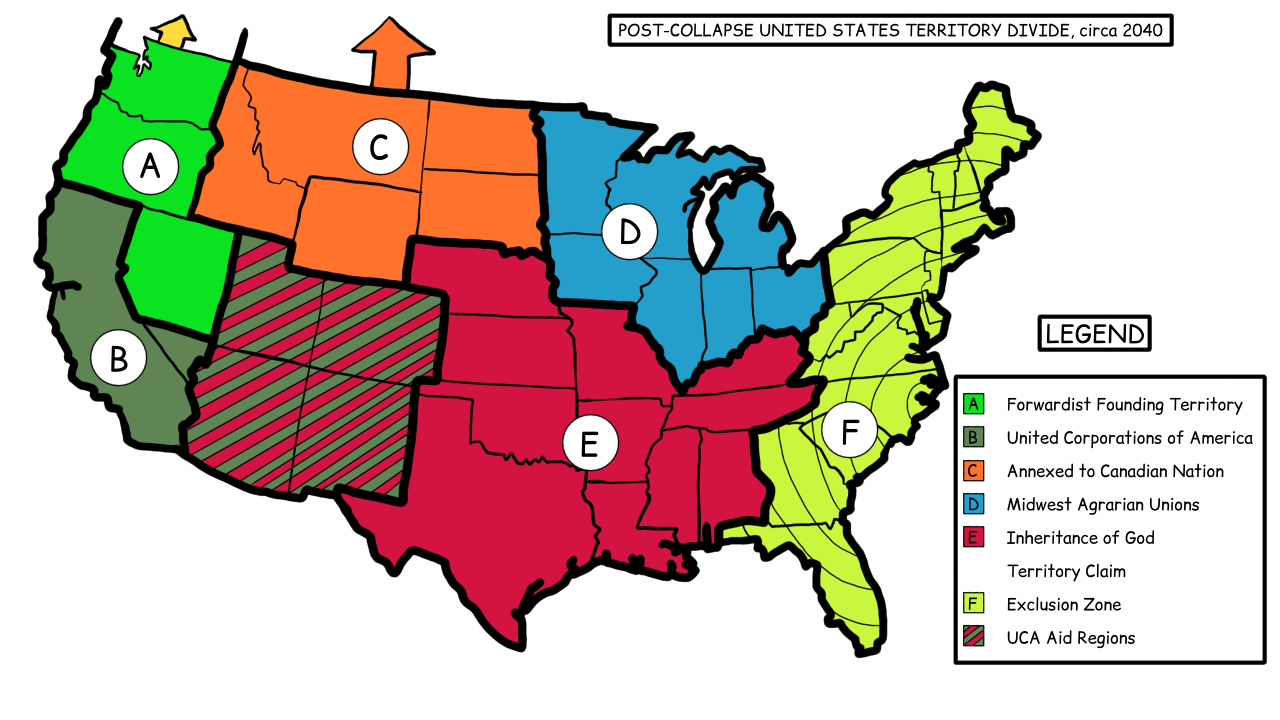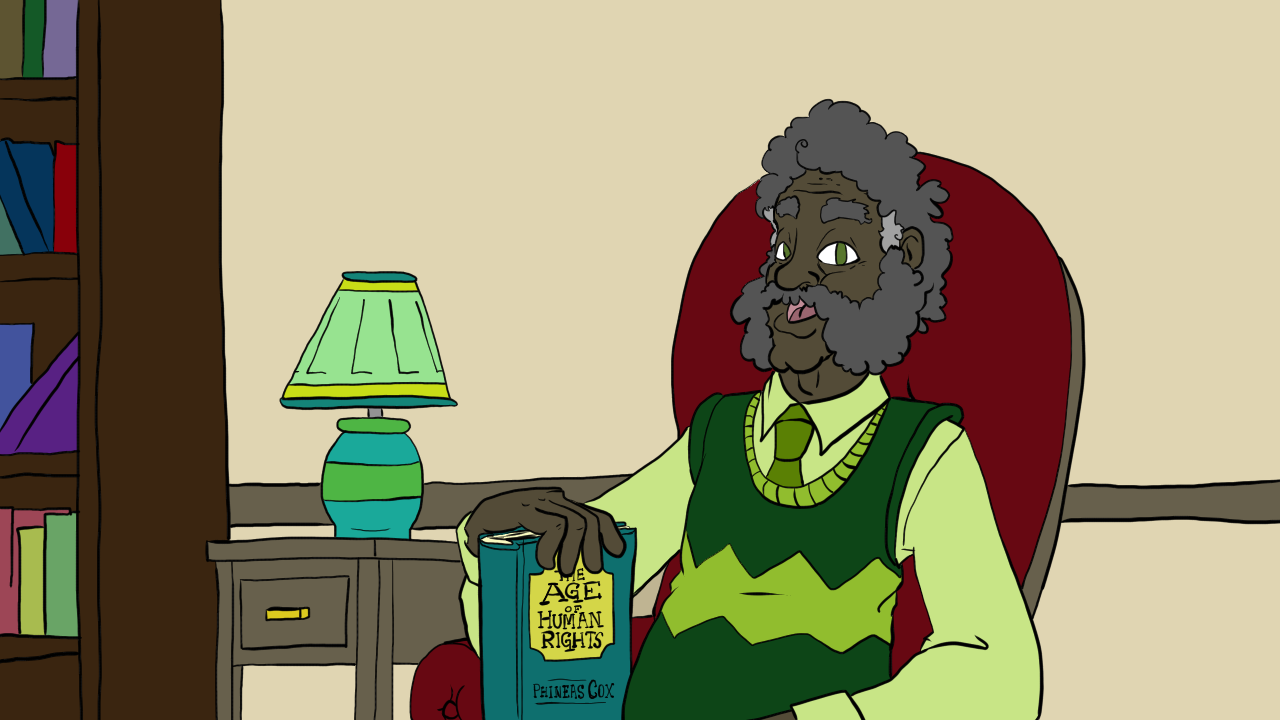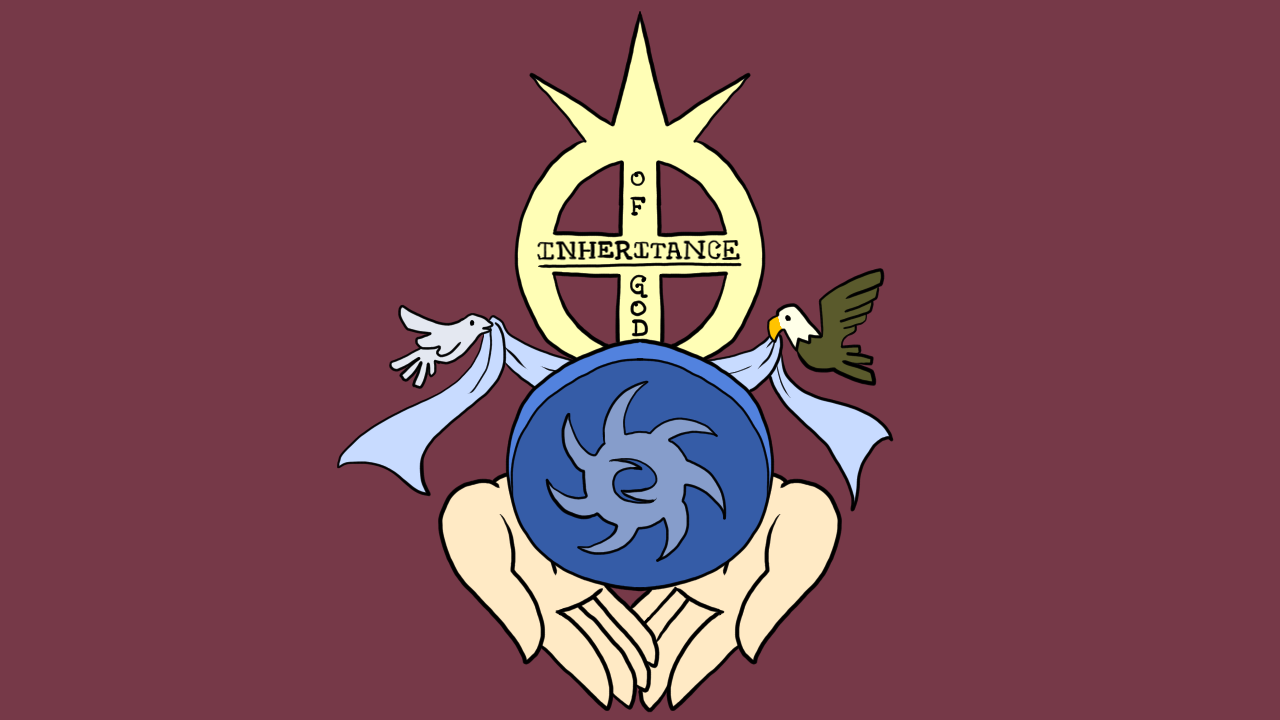Confederation

The Forwardist Confederation is a movement designed to protect the rights and wellbeing of all peoples. It was founded in the 21st century after the American government collapsed when a series of devastating hurricanes caused several nuclear power plants along the Eastern coast of the United States of America to malfunction and go critical. The surrounding lands were rendered uninhabitable, and the citizens that had survived the tragedy were plunged into chaos and confusion without leaders or the structure of the society they had always known.
The main two focus points of the Forwardist Confederation are 1: the ultimate sovereignty of the individual and 2: the well-being of all in the community. The founding members of the Forwardist movement wanted to bring peace to the chaos around them, and they believed the first step was making sure everyone had what they needed to survive. They did not believe in a need to coerce citizens into working to support the community they live in; their foremost belief is that human beings will cooperate with one another to build something better, if given the chance to.
Table of Contents
- 1. History
- A. Pre-Confederation History
- B. Confederation Origin
- C. Early Confederation History
- D. Later Confederation History
- 2. Confederation Organization
- A. Neighborhood
- B. Community
- C. Collective
- D. Association
- E. Aggregate
- F. Confederation
History
Pre-Confederation History
^ Back to table of contents ^In the early 21st century, severe weather events were increasing in both frequency and intensity as a result of climatological changes from the increasing global temperature. Though they had already caused devastation to humans across the globe, the tragedy that happened in 2032 was unprecedented. A string of intense, record-breaking hurricanes in the Atlantic ocean hit the eastern coast of the United States, and among them was one that came to be known as "World-Ender." Its size was unlike anything that had been seen before; its wind diameter was reported to be 1,500 miles across by satellite measurements. When it made landfall, entire towns were leveled along the hurricane's path, but that was far from all. The heavy rainfall, extreme winds, and large debris obliterated 3 nuclear power plants along the eastern coast, and the nuclear fallout devastated the local populace. Almost a third of the United States' population at the time (over 100 million people) were killed, either in the storm or in the aftermath from the radiation. Of course some people survived, and many fled the eastern coast. Refugees from the disaster poured into the states to the west, but there was little infrastructure left to accomodate them, or even the current citizens living there.

The leaders of the nation were lost when the American government fell, almost instantaneously, leaving the country in a chaotic and vulnerable state. The only people left with any recognizable form of power were the nation's corporations, though the economy had entirely broken down. In order to try to stabilize themselves, many of the largest corporations merged together into an entity called the "United Corporations of America," abbreviated as the UCA. They proclaimed that they intended to fix the infrastructure of the country, to repair the damage that had been done to their supply chains, and to make sure all of the nation's citizens were given access to the resources they needed.
The citizens of the country were unsure of what to do or who to trust, and many of them found themselves looking to the UCA and their state's national guard to work together and try to put the pieces of their lives back together. In the first several years, many citizens found it necessary to grow their own crops just to survive, because despite its promises, the UCA was either unable or unwilling to fulfill them. The supply chains remained damaged, and deliveries of essential resources were unreliable. The states further to the west were the ones that had the most access to what they needed, and the closer to the east coast someone lived, the less likely the UCA was to actually provide resources.
In addition to the difficulties with access to resoures, American citizens had been forced to recognize the crisis of climate change, and in turn, they focused their efforts on trying to heal the damage that had been done to the environment. The states' governing bodies proposed ways to do this by reducing carbon emissions as much as possible, as well as prioritizing research into carbon capture. The UCA initially agreed to cooperate with these new requirements, but after only around 5 years, it became clear that they were not willing to prioritize their environmental impact. One by one, the states declared martial law as a means to remove virtually all remaining power from the hands of the UCA.
Other parts of the world were faced with similar (though less devastating) natural distasters. This, along with social discontent ultimately led to global strife that halted all communication between the Americas and the other continents. Although contact would eventually be restored, this meant that the Americans were left with only their immediate neighbors, Mexico and Canada, as allies to help them rebuild, and neither was quick to help due to various circumstances.
Confederation Origin
 ^ Back to table of contents ^
^ Back to table of contents ^
Most of the states that remained had declared martial law, and whenever people resisted the national guard of their state, they were violently repressed. These incidents happened across the country throughout the 2030s. As a means to try to defend from the violence against civilians and to protect their rights, a new movement arose in the northwestern region of the nation called "Forwardism" in the early 2040s. When the movement was still forming as a local program to help return order to Oregon, it was only a small group of citizens from the area who wanted to improve things. The movement began to grow more rapidly when they were joined by a man named "Phineas Cox" from Canada. His brother lived in Oregon, and he'd sent word of the group's formation to Phineas, who was a well-learned man, passionate about philosophy and human rights. He was frustrated by the lack of response from the Canadian government, who had annexed a few states, and then otherwise closed their borders to most American refugees.
Phineas told them of his desire to help them with their organization. In his youth, he had studied human geography, sociology, and all kinds of political theory in the hopes of finding a way to save the world from the impending doom that had been evident for decades. The group was eager to accept him into their ranks when they heard from him, and they convinced him to relocate to America, where he could be a direct part of the movement. He uprooted his life, leaving his position as a philosophy professor at the University of Toronto to move to the states, where he became an icon of the movement. When a member of the group asked Phineas how the group was supposed to put the pieces of the community back together, his famous reply was "Let's move forward," which would later influence the name of the movement.
After his move to Oregon, his first attendance at one of the organizational meetings was fundamental in setting the course of the movement. He insisted that it was critical to provide resources to everyone in the community, no matter whether they were willing or able to help in return. He impressed upon the group that individuals would be more than willing to help with building the community, so long as their basic needs were met, their beliefs were respected, and their rights were guaranteed. While there was initially some dissent among the group, the group agreed to adopt his beliefs, and they ultimately proved to be correct.
Early Confederation History
 ^ Back to table of contents ^
^ Back to table of contents ^
The group aimed to use efficient resource distribution to ensure everyone had what they needed. When the community had their needs met, they were more than willing to help with rebuilding infrastructure, growing food, organizing labor, and much more. For the first time in nearly a decade, the people of Oregon found themselves starting to stabilize and reach an equilibrium. News of this spread to other states, which were still rife with chaos and violence. The states nearest to Oregon were the first to join the confederation, willing to unite when they saw how much things had evened out for the citizens of Oregon.
The movement was centered around the goal of providing safety, shelter, food and water, clothing, and all of the material needs of the people. This was one of many organizations that formed in America around this time, though not all had the same goals or methods. The Forwardist movement was quick to gain traction in states such as Oregon, Washington, and the northern parts of Nevada, as well as even reaching up into Canada around Vancouver. Its focus on maintaining individual liberty for all and its promise to restore peace and organization of society were attractive qualities for the citizens who had been stuck living in chaos, terrified and unsure where their next meal might come from.
Different regions of the country had found other methods of dealing with the chaos. The UCA still remained in the southwest, and had done a minimal amount of work to repair the infrastructure in the area. The southern states were focused on personal freedoms above organizing, and mostly, the citizens focused on taking care of themselves, families, and sometimes their communities. The midwest region (the closest habitable land to the East coast) was filled with refugees from the Eastern states. In order to accomodate the influx of people, communities were restructured, with citizens focusing on growing food for themselves. The northern states between the midwest and the Forwardist movement were annexed by Canada, who had agreed to take them in and help repair and build infrastructure for them, in return for joining the Canadian nation.
Later Confederation History
^ Back to table of contents ^Over time Forwardist ideas spread, and by the turn of the century the Forwardist Confederation extended to cover much of Canada (including their newly-annexed land), as well as reaching to cover the land the UCA had inhabited previously. The movement had also spread its roots to the east by this point, and by 2085 the midwestern citizens accepted the ideas of Forwardism and joined the movement as well.

The southern states remained resistant to the ideas of Forwardism, and the primary group in power in this region was called the "Inheritance of God," or simply the "Inheritance". They were a group of Christian supremacists who believed primarily in self-reliance, and had very little central structure. They had no consistant or meaningful central organization, and they believed instead in a system where individuals sought their own justice. The lack of centralization combined with scores of citizens fleeing to escape the atrocities committed at the hands of the Inheritors further destabilized the region. Those who did not believe in what the Inheritance stood for were forced to leave the area if they disagreed with any of what was happening. There were initially attempts to form new settlements in the area, but the Inheritors began attacking most other settlements that formed in the southern states.
Eventually, the Inheritance's government collapsed under its own weight. When the citizens were left with no support of any kind, an outcry of compassion came from the Forwardist Christians (among others) in the Forwardist communities. They were quick to provide support, offering help rebuilding their communities and access to resources. The citizens of southern states were quick to accept help, glad for the assistance when they had nothing left of their own to rebuild. By 2160, nearly every community in America had joined the Forwardist Confederation. For more details, check out the American History page .
Confederation Organization
^ Back to table of contents ^Forwardist communities were designed to try to optimize life for the Forwardists, and to reduce hierarchies as much as possible. The Forwardist settlements are organized with several levels of structure (both within the settlement and coordination with external settlements) to efficiently provide access to resources, as well as information and roles for guiding the community. There are idealized populations for each of the smaller levels, but in many cases, the actual population may stray from the ideal. Whenever a population of a community grows above its capacity, citizens are encouraged to either leave and fill positions in communities that need more people, or to split and form a secondary community to divide the population between 2 towns.
Each level of organization within the confederation serves a purpose, and is responsible for adding something to the lives of the Forwardists. Not all communities will be structured in the exact same way, but they do share common attributes to improve the efficiency within the communities.
Neighborhood
^ Back to table of contents ^This is the smallest functional unit in the confederation. Neighborhoods are designed to house approximately 70 to 100 people each. This is the level that handles most of the resource distribution (such as food, shelter, water, etc.) for all of its residents. The specific needs of individual citizens are typically brought first to the neighborhood to be fulfilled if possible, and any needs that the neighborhood can't fulfill are passed to the community to fulfill. For example, if someone's water heater broke, they would find out if their neighborhood had any available before moving to ask the rest of the community.
Community
^ Back to table of contents ^A community is a collection of neighborhoods that share a similar culture(s), way(s) of living, and identity. Each community will typically have about 10 neighborhoods, housing around a total of 700 to 1000 residents. The community is responsible for providing the resources and the civil services such as hospitals that neighborhoods distribute. In return for having their needs met, most citizens provide approximately 20 labor hours to their community each week.
The community is the level where civil contracts are held with each individual of the community that outlines the expectations of each party. The expectations for individuals are things such as their labor contributions. The expectations of individuals for their community include things such as having housing, food, water, medical care, access to education, etc. If there is a contract breach on either side, the community and the individual are both able to be held accountable, which begins with an investigation into whatever has caused the breach.
Collective
^ Back to table of contents ^The collective is the level where communities interact with other nearby communities that share similar identities and can coordinate their efforts in various ways. Communities often exchange resources, information, labor, and more within these groups, which helps to ensure that everyone is able to have what they need as well as allowing communities to specialize to some degree.
The size of collectives tends to be around ten communities (~10,000 people), but this can vary. Most of the time, collectives are made up of communities that are located near one another, but at times the collective will add communities that are much further away to their numbers. This can allow for greater range of information and resource exchanges.
Association
^ Back to table of contents ^The level of the association is equivalent to what used to be known as a "state" in the United States of America. At this level, much of the important inter-community organization occurs within a select physical boundary, which are in many cases the same as the boundaries of the 21st century states. This level exists partially to maintain history of the individual states. The borders of the associations are defined only for the purposes of organizing rather than being exclusionary boundaries that prevent travel of people, goods, ideas, etc. The ideas of Forwardism specifically condemn the concept of a "state/nation," and as such, this level has little to no power over the lives of its citizens.
The main productive focus at this level is on creating and maintaining a militia to protect the association and its residents from any incoming threats. While threats have grown infrequent as the confederation has stabilized, the decision to maintain militias was made so that none of the citizens would ever be left without a way to defend themselves. A smaller subsection of the milita is the "human rights enforcement" section. This group forms smaller groups of 3 people (1 social worker, 1 investigator, and 1 guard) that visit each community in the association. Their main job is to ensure that the rights of the individuals are not being infringed upon by the community or any other party.
Firearms and training are controlled by the militia of the association. If a citizen wants to use a firearm, they first must be trained and certified by the milia. Rules about firearm ownership and usage are regulated by the milia as well, and it can vary from one place to another. For any citizen who wants self-defense, the milia can provide access to training on how to defend yourself, as well as providing freely available non-lethal weapons (such as a taser).
Because there are so few threats in the confederation, most of the day-to-day work of the milia is centered on hunting and the training of hunters. Most of the weapons that are owned are rifles and bows for hunting wildlife to help maintain populations as needed and to provide meat for the communities.
Aggregate
^ Back to table of contents ^This level is similar to the idea of a region, and is only used in some cases. Particularly, this level is used to support the exchange of goods between communities that live in an area that lacks one (or more) of the basic material needs of people. This is most often situations where there is little arable farmland in a community, leaving them without sufficient food. In order to accomodate this, the aggregate provides infrastructure for transporting goods to these communities, as well as offering options of services or goods that can be given in exchange, based on the resources available.
Other examples of where the aggregate is active can be seen in situations where there are labor shortages. For instance, if a population is aging into retirement, the aggregate level can be appealed to encourage younger members of the confederation to move to the area to reinvigorate it.
Confederation
^ Back to table of contents ^The confederation is the highest level of the movement. There is very little organization or power at this level. This level is almost exclusively for defining the broadest and most important human rights that the movement protects. All humans are entitled to the right to live free of coersive hierarchies and all forms of abuse and exploitation. The confederation stands as a union between the followers of Forwardism in the Americas, and their shared commitment to build a better world.
^ Back to table of contents ^